Gigabyte Z77X-UP7 Review: OC Oriented Orange Overkill
by Ian Cutress on March 1, 2013 10:30 AM EST- Posted in
- Motherboards
- Intel
- Gigabyte
- Z77
MultiCore Turbo
Frequent readers of our motherboard reviews at AnandTech will have come across the term MultiCore Turbo. In a nutshell, when XMP is enabled, the motherboard adjusts the multiplier of the CPU to its highest Turbo bin for all loading – such that instead of 39x/39x/38x/37x for an i7-3770K, we get 39x across the board. This has obvious implications for multithreaded workload, which we explained and ‘asked the readers’ in a recent news item. Most motherboard from the major manufacturers (ASUS, Gigabyte, and now ASRock + MSI) has this option enabled by default when XMP is enabled, or a variation therein. It was originally designed to help certain users with software that had variable loading to stay stable, as well as speed them up to a small degree – the knock on effect is that for reviews, it shows up in the benchmarking when testing the out-of-the-box performance. For users intending to overclock, MCT is nothing to worry about.
For the Gigabyte Z77X-UP7, MultiCore Turbo is part of the BIOS used in testing.
3D Movement Algorithm Test
The algorithms in 3DPM employ both uniform random number generation or normal distribution random number generation, and vary in various amounts of trigonometric operations, conditional statements, generation and rejection, fused operations, etc. The benchmark runs through six algorithms for a specified number of particles and steps, and calculates the speed of each algorithm, then sums them all for a final score. This is an example of a real world situation that a computational scientist may find themselves in, rather than a pure synthetic benchmark. The benchmark is also parallel between particles simulated, and we test the single thread performance as well as the multi-threaded performance.
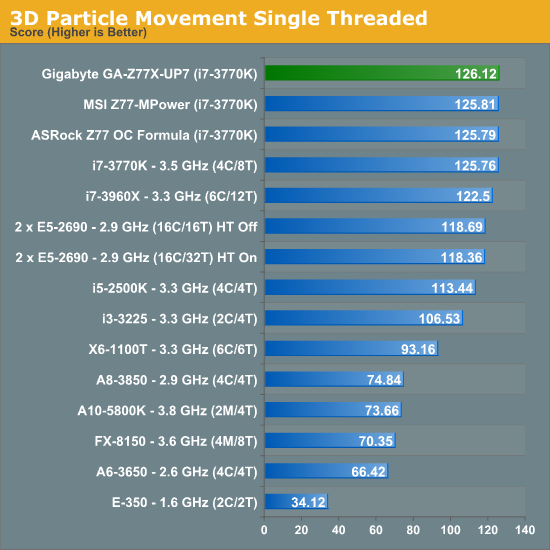
The single threaded version of 3DPM is more of a task in efficiency than anything else, and the UP7 hits the high notes, above the Z77 OC Formula and MPower, with ease.
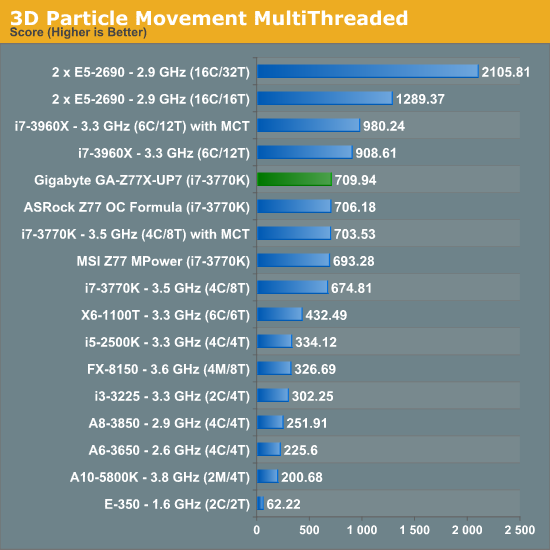
The Gigabyte Z77X-UP7 quite handsomely takes the 3DPM-MT crown out of all the Z77 motherboards using MCT, above the Z77 OC Formula. (The G1.Sniper 3 uses MCT-Plus, rising up to 4.0 GHz.)
WinRAR x64 3.93 - link
With 64-bit WinRAR, we compress the set of files used in the USB speed tests. WinRAR x64 3.93 attempts to use multithreading when possible, and provides as a good test for when a system has variable threaded load. If a system has multiple speeds to invoke at different loading, the switching between those speeds will determine how well the system will do.
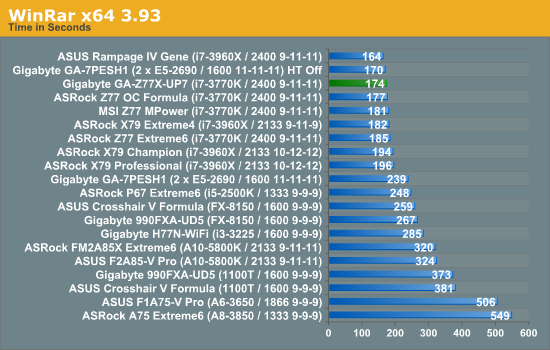
The efficiency shown in 3DPM-MT follows through to WinRAR, where the UP7 is two seconds behind the top Z77+MCT motherboard, and three seconds ahead of the ASRock Z77 OC Formula.
FastStone Image Viewer 4.2 - link
FastStone Image Viewer is a free piece of software I have been using for quite a few years now. It allows quick viewing of flat images, as well as resizing, changing color depth, adding simple text or simple filters. It also has a bulk image conversion tool, which we use here. The software currently operates only in single-thread mode, which should change in later versions of the software. For this test, we convert a series of 170 files, of various resolutions, dimensions and types (of a total size of 163MB), all to the .gif format of 640x480 dimensions.
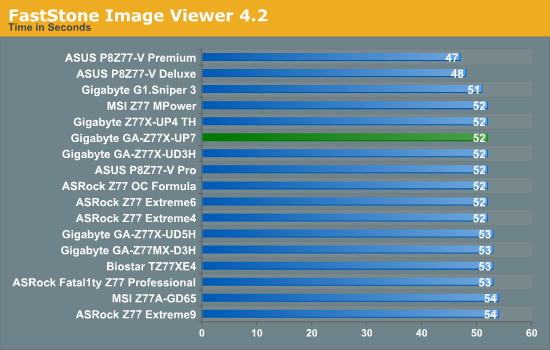
Across the range FastStone shows up very few variances due to its single-threaded runtime. The UP7 fits in the 52 second category, along with most Z77 boards. The high end ASUS boards are still kings for FastStone.
Xilisoft Video Converter
With XVC, users can convert any type of normal video to any compatible format for smartphones, tablets and other devices. By default, it uses all available threads on the system, and in the presence of appropriate graphics cards, can utilize CUDA for NVIDIA GPUs as well as AMD APP for AMD GPUs. For this test, we use a set of 32 HD videos, each lasting 30 seconds, and convert them from 1080p to an iPod H.264 video format using just the CPU. The time taken to convert these videos gives us our result.
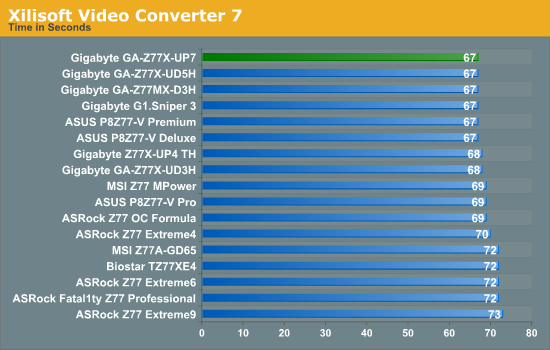
At full loading across all threads to convert video, and some memory overhead, all Z77 motherboards have fit in the 67-73 second window, albeit making ~9% from top to bottom. The UP7, like most Gigabyte boards, fits in the 67 second bracket, two seconds ahead of the ASRock Z77 OC Formula and MSI Z77 MPower.
x264 HD Benchmark
The x264 HD Benchmark uses a common HD encoding tool to process an HD MPEG2 source at 1280x720 at 3963 Kbps. This test represents a standardized result which can be compared across other reviews, and is dependant on both CPU power and memory speed. The benchmark performs a 2-pass encode, and the results shown are the average of each pass performed four times.












41 Comments
View All Comments
madmilk - Friday, March 1, 2013 - link
You're not going to find what you want in a 7-slot ATX form factor. However, dropping down your x16 GPU requirement makes possible with water cooling and a good X79 motherboard.Moving up to Xeon opens up some more options. One is this: http://www.avadirect.com/tower-server-configurator... Real PCIe 3.0 x16 Quad-SLI, plus two more PCIe 3.0 x8 and one PCIe 2.0 x4.
Getting those last PCIe lanes is very, very expensive, and completely worthless for anything but GPU compute.
JeBarr - Saturday, March 2, 2013 - link
I'm hoping for a few new motherboards with the next enthusiast platform refresh. Ideally 10 slot to make room for all the expansion cards a gamer geek could possibly use :DSamus - Friday, March 1, 2013 - link
Can you use all 5 pcie x16 slots simultaneously with single-slot GPU's, obviously not in SLI?Samus - Friday, March 1, 2013 - link
You answered my question above, thanks!sherlockwing - Friday, March 1, 2013 - link
You said:If Gigabyte was going for more sales, from my perspective, if some of the IR3550s were removed and the system reduced to just over $300, it might get more takers
What Gigabyte does have on the market is the http://detonator.dynamitedata.com/cgi-bin/redirect...">UP5-TH for about $250.
It have the exact same PWM chip in the VRM as the UP7 (8 phase IR3563), only that UP7 runs it through a quadrupler for 32 VRM phase while UP5 don't use any so it runs only 8 IR3550 but 8*60= 480A is already overkill for Ivy Bridge.
The only other thing UP5-TH misses other than VRM phase overkill is the PLX chip, so it can't run 4 way SLI/CLX, and can only run 3 way at 8X/4X/4X. But for people running 2 cards or less it is more than enough.
UP7 is a halo product/ultra flagship just like the GTX Titan, UP-5TH is the mainstream Flagship.
IanCutress - Friday, March 1, 2013 - link
Yup, we reviewed the UP4 TH: http://www.anandtech.com/show/6296/Though that goes along their Thunderbolt line. The Thunderbolt controller isn't cheap. But as mentioned the comparison is the G1.Sniper 3 with the PLX, or the Z77X-UD5H without the PLX (or Thunderbolt).
Ian
mayankleoboy1 - Friday, March 1, 2013 - link
Y U no use WinRAR 4.2 ?Its much better multithreaded.
IanCutress - Friday, March 1, 2013 - link
To maintain consistency with the last 18 months of benchmark results ;) Should probably do an update for Haswell later this year though.Ian
Kevin G - Friday, March 1, 2013 - link
For a user putting down $400 for a motherboard, especially one aimed at overclocking and high performance, why not go the LGA 2011 route and X79? In this price range, LGA-1155 and Z77 just don't seem to be premium products in comparison.baberpervez - Friday, March 1, 2013 - link
Why in the world is Gigabyte focusing on the LG1366 market? With all new cpus being LG1155 or 2011, seems counterproductive to produce a unit for an older motherboard kind. Even with my I7 960 I don' tknow why anyone would want to upgrade to this product. With triple -SLI (570s) a fourth slot is useless since the cards are only 3 way capable, but definitely worth experiementing on for 480's/580s/680s.The price is what it is, very hefty...and only serious overclockers would want to purchase this.
If Nvidia made the 570 quad sli than I would consider getting this, but there's no chance of me replacing three cards to go into a higher configuration anytime soon.
This board would have done very well a few years ago...
Just not convinced LG1366 was a good idea.